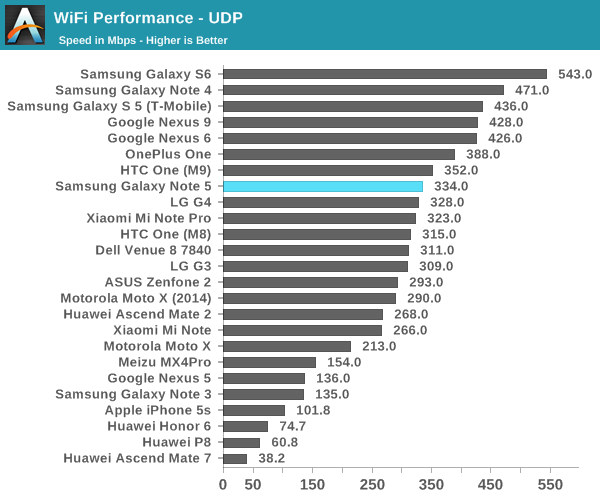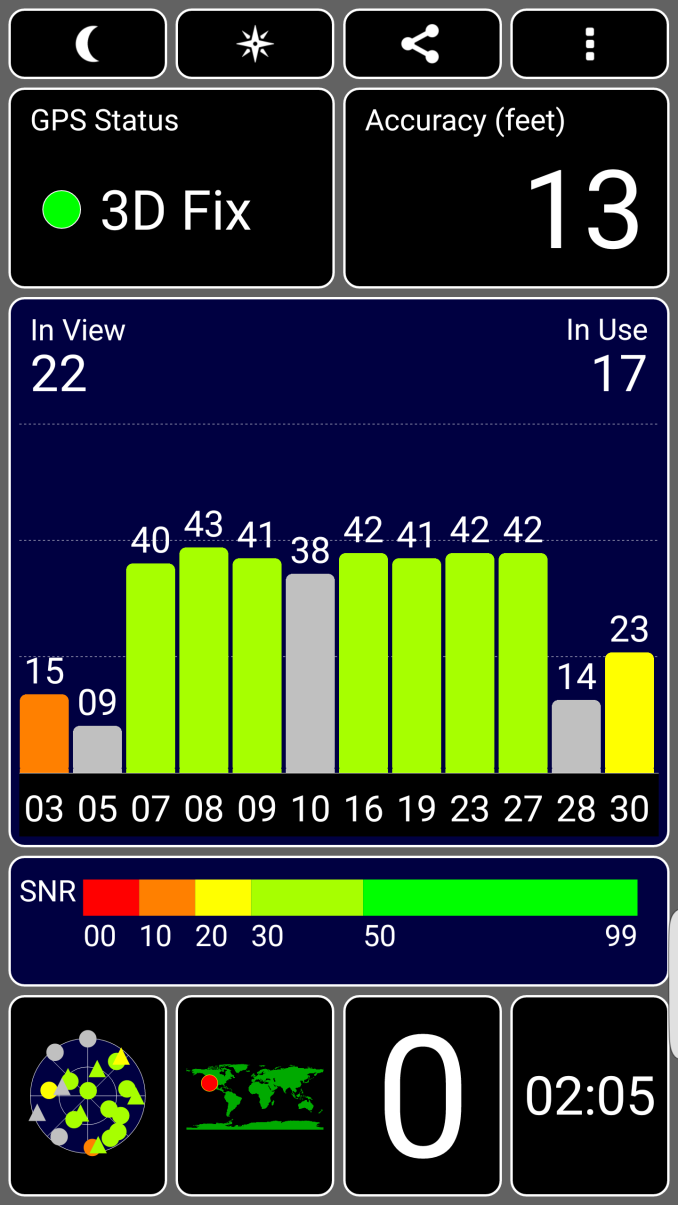The Samsung Galaxy Note5 and Galaxy S6 edge+ Review
by Joshua Ho on October 2, 2015 8:00 AM ESTVideo Performance
Now that we’ve taken a look at still image performance, we can look at video performance. For the most part these results should be similar to still image performance, but we’re looking at encoder efficiency, good sound recording, and effective stabilization. The Galaxy Note5 and Galaxy S6 edge+ both have OIS in order to improve stability in video recording, and for the most part the feature set of both is similar to the Galaxy S6 when it comes to video.
Galaxy Note5
Galaxy S6
Galaxy Note5
iPhone 6
For 1080p30, Samsung has elected to use 17Mbps High Profile H.264, along with a 256 Kbps stereo audio channel encoded with AAC. If this sounds familiar, it's because this is shared with the Galaxy S6. Quality is indistinguishable. Unfortunately, it seems the same sort of jerky OIS reset effect is still present although it isn't too obvious in these videos.
Galaxy S6
iPhone 6
It probably goes without saying, but once again the Galaxy Note5 shares the same video encode settings with the Galaxy S6, with 28 Mbps High Profile H.264 encoding for 1080p60 video. In these samples you can more clearly see the issues that come with OIS in video, which is that there are instances of jerky video movement when it should be relatively smooth, even if it's shaky. The only real difference between the Galaxy S6 and Note5/S6 edge+ is that the Note5 removes a bit of the yellow tinge/saturation boost that we see in the Galaxy S6. There's otherwise relatively little to comment on here.
Once again, not much is different when comparing the Galaxy Note5 and Galaxy S6 edge+ to the Galaxy S6 other than saturation differences in some cases. The same encoder settings are also used for 48 Mbps HP H.264 with 256 Kbps AAC stereo audio.
Galaxy Note5
Galaxy S6
Galaxy Note5
iPhone 6
If you're able to read the trend, you can probably guess that the Galaxy Note5 and S6 edge+ are going to share the same encode profiles as the Galaxy S6, which is 48Mbps HP H.264. Once again, quality is effectively identical here and the changes are slim to none. This unfortunately means that the iPhone 6 still leads here as the quality of the slow motion video on the Galaxy Note5 and Galaxy S6 line weren't much good to begin with.
WiFi Performance
For the most part, it probably goes without saying that one of the cornerstones of a smartphone or phablet is mobile data. After all, without mobile data you’re effectively limited by whatever WiFi hotspot you can find, which is often limited in range. Comparatively speaking, mobile data is generally more versatile. However, in the case of most mobile devices WiFi is often used at home in order to utilize a normally lower-latency connection with generally higher throughput. Given the reality of data caps, WiFi is also often needed for things like app updates, video streaming, and possibly music streaming. As a result, poor WiFi can sink a phone. In order to try and get a basic measure of performance, we look at peak UDP bandwidth using iPerf. In the case of the Galaxy Note 5, Samsung has upgraded the WiFi chipset from the BCM4358 used in the Galaxy S6 to Broadcom’s BCM4359. This is supposed to allow connections to 2.4 and 5 GHz WiFi simultaneously, but in practice it doesn’t really look like it’s used outside of potentially faster scanning.

Interestingly, I was unable to get the download speeds that I was expecting from a 2x2 802.11ac WiFi solution despite using 5 GHz. It's possible that this is due to interference as I can't isolate the system from other WiFi hotspots in the area, but in my experience I never had any real issues with WiFi that I could notice. Reception doesn't seem to be any better or worse than other devices I've tried in recent memory.
GNSS Performance
GNSS is often critical to a mobile device these days, as a number of applications rely on highly accurate location in order to work properly. Probably the most obvious case here is going to be GPS navigation, but things like lost/stolen device location, geofencing, location-based check-ins, and other applications are all generally quite reliant on accurate location that only GNSS systems can provide. In the case of the Galaxy Note5 and Galaxy S6 edge+, we see that the GNSS module is shared with the Galaxy S6 for the Shannon modem variants as a BCM4773 GNSS location hub is present within the system.
In practice, I didn’t find much wrong with this solution. Time to first lock without any assistance data took about 30 seconds, and at the 46 second mark the maximum possible accuracy was achieved. With assistance data, a position fix was reported within 5 seconds of launching the GPS Test app. Overall, I doubt anyone will face any real problems dealing with GPS/GNSS location on these devices.











225 Comments
View All Comments
lopri - Friday, October 2, 2015 - link
Also odd that the author thinks the color shift on the Edge+ is due to RGBG subpixel layout. I thought the color shift would be there due to curves regardless of subpixel layout.In any case I give the author props for this effort. A rather thorough review, even if a little heavy on editorials.
lilmoe - Friday, October 2, 2015 - link
After being called out so many times, your "comparison charts" are still an absolute (intentional?) mess. Why do you have 25 different phones on one chart, and 10 completely different ones on others? Why is the crappiest browser on Android still being used for battery tests? Why is the iPhone 6 in GPU tests and the 6plus absent?While they do have really nice articles, Anandtech scores the lowest in the consistency department out of all sites. Please try being more consistent.
Can you just put 4-5 most popular phones of each platform on the SAME darn charts and keep them that way, without conveniently leaving some out and putting them back here and there? Like PLEASE?
Also, it would be nice if you'd explain why you're posting NAND performance benchmarks with your particular set of settings. I seriously find it VERY hard to believe that UFS 2.0 is equal or often slower than the very best of eMMC in sequentials and randoms.
lopri - Friday, October 2, 2015 - link
The real mess is the camera samples. (which by the way is not limited to Android devices for a change) It is maddening to sift through camera samples without knowing ahead what I am going to see only to click dozen more times to find out what I am looking for.Kuzi - Saturday, October 3, 2015 - link
Agreed their charts are a mess.Bob Todd - Friday, October 2, 2015 - link
The gigantor phone market is more competitive than ever, so it's interesting to see them dropping features and generally not taking full advantage of being the most vertically integrated Android OEM. They dropped microSD but capacity maxes out at 64GB. They had the opportunity to be ballsy and go higher capacity PCIe NVMe and absolutely crush every other Android OEM in storage performance. You have to *really* want the pen, because this looks like a tough sell at $780 for 64GB when $650 gets you a 128GB Nexus 6P and $500 gets you a 64GB Moto X Pure with expandable storage. Sure Samsung's SOC is better, but this is a pretty underwhelming release for me.TheinsanegamerN - Friday, October 2, 2015 - link
Not to mention the sealed, non removable battery. And samsung's terrible track record with updates.thedons1983 - Sunday, October 18, 2015 - link
Sealed, non removable battery = better looking device. Simple as. Never mind the fact, that most users do not want to swap the battery, as they simply don't need to. How obsessed with your phone are you anyway? You should probably try getting a life instead!!lilmoe - Friday, October 2, 2015 - link
Samsung knows a thing or two about fast storage, and their UFS 2.0 is pretty darn GOOD. It's just not showing well on you-know-who's charts.Bob Todd - Friday, October 2, 2015 - link
You are missing the point. They are charging more than "good enough" money for this thing. They need to offer compelling reasons to spend way more on this than the other solid new entries in this segment. Something like a PCIe NVMe solution would have been a good way to justify that price gap. I predict steep discounts (~$100+) shortly after launch.lilmoe - Friday, October 2, 2015 - link
"I predict steep discounts (~$100+) shortly after launch"They already priced the Note 5 cheaper than the Note 4 at launch. Sorry if American carriers are over charging.
"You are missing the point"
Read my *short* comment again. Their storage solution isn't particularly inferior. Random reads and writes are comparable, if not better. If you honestly believe that sequential performance is more important than random for everyday workloads, then I have nothing else to tell you. It's not like we have an extensive comparison of performance and power consumption/efficiency between Samsung's UFS 2.0 vs Apple's sourced NVMe solution (might not even be possible at this stage), nor is it the case that Samsung has already developed a miniature PCIe V-NAND 950 PRO NVMe SSD and is holding back to "cut corners".
Everything in this segment is overpriced, for better or worse. We just learn to "deal with it". That said, your point boils down to overall manufacturer costs, ie: BoM. You shouldn't make assumptions on your own over bits and pieces of the package. Samsung, despite manufacturing most of their parts, have a costlier BoM than most other OEMs, including Apple. Their external enclosure, AMOLED screens, Wacom Digitizers, DACs, etc. are always best in class and cost more than comparable parts from the competition. Other than the omission of SD-card controller, they went all out in every other detail (removable batteries don't contribute to cost, it's a design choice rather).
That said, I'd rather have them start with 64GB of standard storage (128GB option) and an SD-Card slot for a much more value proposition at that price range. A larger ~4000mah battery would have also been possible since the Note 5 is relatively large but is one of the lightest "phablet" out there. This goes for all manufacturers, not only Samsung.